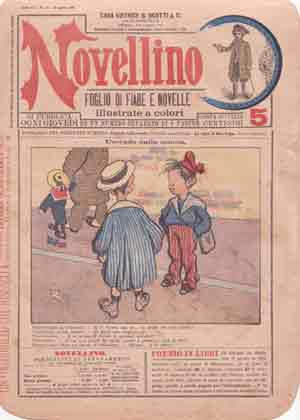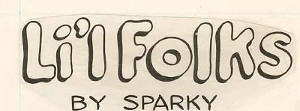
Alfred Gerald Caplin, better known as Al Capp, was an American cartoonist and humorist best known for the satirical comic strip Li'l Abner, which he created in 1934 and continued writing and drawing until 1977. He also wrote the comic strips Abbie an' Slats and Long Sam (1954). He won the National Cartoonists Society's Reuben Award in 1947 for Cartoonist of the Year, and their 1979 Elzie Segar Award, posthumously for his "unique and outstanding contribution to the profession of cartooning".
A comic strip is a sequence of cartoons, arranged in interrelated panels to display brief humor or form a narrative, often serialized, with text in balloons and captions. Traditionally, throughout the 20th and into the 21st century, these have been published in newspapers and magazines, with daily horizontal strips printed in black-and-white in newspapers, while Sunday papers offered longer sequences in special color comics sections. With the advent of the internet, online comic strips began to appear as webcomics.

Dick Tracy is an American comic strip featuring Dick Tracy, a tough and intelligent police detective created by Chester Gould. It made its debut on Sunday, October 4, 1931, in the Detroit Mirror, and was distributed by the Chicago Tribune New York News Syndicate. Gould wrote and drew the strip until 1977, and various artists and writers have continued it.

Peanuts is a syndicated daily and Sunday American comic strip written and illustrated by Charles M. Schulz. The strip's original run extended from 1950 to 2000, continuing in reruns afterward. Peanuts is among the most popular and influential in the history of comic strips, with 17,897 strips published in all, making it "arguably the longest story ever told by one human being"; it is considered to be the grandfather of slice of life cartoons. At the time of Schulz's death in 2000, Peanuts ran in over 2,600 newspapers, with a readership of roughly 355 million across 75 countries, and had been translated into 21 languages. It helped to cement the four-panel gag strip as the standard in the United States, and together with its merchandise earned Schulz more than $1 billion.

Li'l Abner was a satirical American comic strip that appeared in multiple newspapers in the United States, Canada, and Europe. It featured a fictional clan of hillbillies living in the impoverished fictional mountain village of Dogpatch, USA. Written and illustrated by Al Capp (1909–1979), the strip ran for 43 years, from August 13, 1934, through November 13, 1977. The Sunday page debuted on February 24, 1935, six months after the daily. It was originally distributed by United Feature Syndicate and later by the Chicago Tribune New York News Syndicate.

Fearless Fosdick is a long-running parody of Chester Gould's Dick Tracy. It appeared intermittently as a strip-within-a-strip, in Al Capp's satirical hillbilly comic strip, Li'l Abner (1934–1977).
See also: 1920s in comics, other events of the 1930s, 1940s in comics and the list of years in comics

Italian comics, also known as fumetto, plural form fumetti, are comics that originate in Italy. The most popular Italian comics have been translated into many languages. The term fumetto refers to the distinctive word balloons that contain the dialogue in comics.

Li'l Folks, the first comic strip by Peanuts creator Charles M. Schulz, was a weekly panel that appeared mainly in Schulz's hometown paper, the St. Paul Pioneer Press, from June 22, 1947, to January 22, 1950. Schulz's first regular cartoon, Li'l Folks can be regarded as an embryonic version of Peanuts, centered around children saying things beyond their years; unlike Peanuts, Li'l Folks did not feature any recurring characters, though several themes were carried over to the later strip, including Beethoven's music ; dogs resembling Snoopy that appeared in most strips; and the name Charlie Brown.
Notable events of 1952 in comics.
Notable events of 1950 in comics.
Sergio Toppi was an Italian illustrator and comics author.

GoComics is a website launched in 2005 by the digital entertainment provider Uclick. It was originally created as a distribution portal for comic strips on mobile phones, but in 2006, the site was redesigned and expanded to include online strips and cartoons. GoComics publishes editorial cartoons, mobile content, and daily comics. It is currently owned by Andrews McMeel Universal.
Comic strip formats vary widely from publication to publication, so that the same newspaper comic strip may appear in a half-dozen different formats with different numbers of panels, different sizes of panels and different arrangement of panels.
Charlie Mensuel was a French monthly comics magazine. Its publication began in February 1969, and ceased in February 1986.
Toby Press was an American comic-book company that published from 1949 to 1955. Founded by Elliott Caplin, brother of cartoonist Al Capp and himself an established comic strip writer, the company published reprints of Capp's Li'l Abner strip; licensed-character comics starring such film and animated cartoon properties as John Wayne and Felix the Cat; and original conceptions, including romance, war, Western, and adventure comics. Some of its comics were published under the imprint Minoan. Some covers bore the logo ANC, standing for American News Company, at the time the country's largest newsstand distributor.
Li'l Abner: The Complete Dailies & Color Sundays, also known as The Complete Li'l Abner, is a series collecting the American comic strip Li'l Abner written and drawn by Al Capp, originally distributed by the syndicate United Feature Syndicate and later by Chicago Tribune New York News Syndicate, in total during 43 years before the strip ended. The strip debuted in August 1934 and at its peak, it had an estimated readership of over 60 million people regularly. The collection is published by The Library of American Comics.








